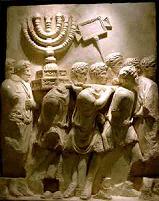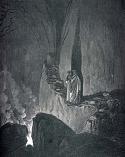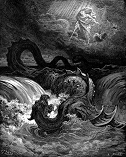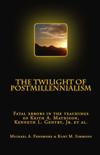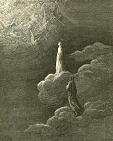Don Preston on the Millennia
(Both of Them)
Don is a great guy and good friend.
We come from the same church background and hold many of
the same ideas. Even
so, there are several places where are views significantly
differ. Don recently
published a piece on his view of the 1,000-years in Revelation
twenty. In the
spirit of brotherly dialogue, I thought it would be useful to
interact casually with a couple of Don’s points.
The Millennial Reign of
Christ (NOT!)
Don entitled his piece “The Forty-Year
Millennium.” It is
Don’s view that the forty-year period between Christ’s ministry
and the fall of
“The beginning of the Millennium is the
beginning of Messiah’s conquering work.
The Millennium reign is the consolidation of Messiah’s
rule. The end of the Millennium is when the work was perfected.”
Thus, by Don’s view, the Millennium has
specific reference to the reign of Christ.
We feel this is a mistake.
Indeed, we feel the idea of a “millennial reign of Christ”
is the fundamental mistake that runs throughout
most millennial themes.
The scriptures are silent about a
millennial reign of the Messiah.
Not once does the concept appear anywhere in the Bible.
Not a single verse can be produced that mentions or even
alludes to such a concept.
All notions about an “interim,” “transitional,” or
“consolidating” reign are totally away from scripture.
Virtually every passage of scripture, Old or New, which
describes Christ’s reign, places its beginning at his ascension,
whence it continues without interruption…forever.
Don, on the other hand, makes the reign begin on earth
and last for only 1,000 years, an approach I feel is at odds
with scripture:
Ps. 110-1 – “The Lord said unto my Lord, Sit
thou at my right hand, until I make thine enemies thy footstool.
The Lord shall send the rod of thy strength out of
Isa. 9:7 - “Of the increase of his government
and peace there shall be no end, upon the throne of David, and
upon his kingdom, to order it, and to establish it with judgment
and justice from henceforth even forever.”
Dan. 7:13 - "I saw in the night visions, and,
behold, one like the Son of man came with the clouds of heaven,
and came to the Ancient of days, and they brought him near
before him. And there was given him dominion, and glory, and a
kingdom, that all people, nations, and languages, should serve
him: his dominion is an everlasting dominion, which shall not
pass away, and his kingdom that which shall not be destroyed."
These are just a few of the more prominent
passages describing Christ’s reign.
Notice that in each case the rule begins with Christ’s
ascension, not on earth as supposed by Don.
Moreover, none of these delimits or otherwise qualifies
Christ’s rule. There is no hint of a millennial reign. Jesus
ascended to God’s right hand where he was proclaimed King of
kings and Lord of lord; he rules the nations with a rod of iron.
The reign that began at Jesus’ ascension is forever.
Period. No qualification.
Don cites Heb. 2:8 “But now we see not yet
all things put under him.”
Don argues that, since at the end of the millennium all
enemies would be put beneath Christ’s feet, therefore the
millennium is defined by the period of Christ’s
conquering. Says Don,
“Christ was currently reigning, and would
continue to reign until his enemies were put under Him.
The time of his rule is the time of the putting down of
his enemies…The end of the Millennium is when that work was
perfected.”
But this is clearly wrong.
The 1000-year internment of the dragon ended when it was
loosed to persecute the anew church.
Don agrees with this and correctly observes that the
revelation of the “man of sin” in II Thess. 2:8 equals the
loosing of the dragon in Rev. 20:7.
This loosing of the dragon/revelation of the man of sin
began the persecution that is the subject of Revelation.
Revelation was written to prepare the church for the coming
persecution under Nero and the Jews.
The actors in this battle (persecution) include the
dragon (
In reality, the 1000-years have no
reference to Christ at all. Instead, they refer to the
internment of dragon on the one hand (Rev. 20:1-3), and to the
martyrs and righteous dead on the other (v. 4-6).
Christ reigns forever.
The righteous dead and martyrs share for a time in
that reign (“1000 years”) from Hades Paradise.
However, Don transfers the 1000-year periods from
the dragon and righteous dead, and applies them to Christ.
This not only creates an “interim reign” of which the scripture
are silent, but also negates the “other-worldly” nature of the
millennial periods and makes them descriptive of earthly time
(“forty-years”) and events.
Peter is very clear that in the spiritual realm, “one day
is with the Lord as a thousand years and a thousand years as one
day” (II Pet. 3:8). Thus, use of a 1000-years speaks directly to
the other-worldly nature of time in the spiritual realm.
This is equally true of the dragon, beast and martyrs in
Revelation twenty: the dragon and beast having received a mortal
wound to the head went down to Hades Tartarus for a symbolic
period of 1000-years. The martyrs having been beheaded for the
testimony of Christ went to Hades Paradise for 1000-years where
they waited the general resurrection. Don is mistaken to apply
the symbolism of 1000-years to earth and to Christ.
Describes Two Millennia,
but Supposes only One
Throughout his article, Don supposes but a
single millennium, framed by the ministry of Christ (Matt.
“The Millennium terminated forty years
later at the resurrection...the end of the Millennium is also
the time of the Resurrection.”
We agree with Don that the reign of the
righteous dead and martyrs ended at (by) the general, Hadean
resurrection in A.D. 70.
However, Don’s supposition that a single millennium is
contemplated by the text is belied by the fact Don says
(correctly) that the persecution of the man of sin (Nero) begins
when the dragon is loosed.
“At the end of the Millennium we see:
Satan released; his making war with the saints; his final
destruction. In the
New Testament we see: Satan released (‘The Devil walks around
seeking whom he may devour’ I Pet. 5:8); his making war with the
saints (the saints had to suffer ‘a little while’ I Pet. 1:4f;
cf. Rev. 12:10).”
Thus, according to Don, the millennium is
over when the dragon is loosed. The dragon is loose when the
eschatological persecution under Nero begins.[2]
The persecution under Nero began in A.D. 64. Don places
the general resurrection at A.D. 70, a six-year difference.
How can the text contemplate a single millennium when the
binding of the dragon does not extend unto the Hadean
resurrection?
Consider:
- The dragon is bound 1000 years
- The martyrs and righteous dead reign with Christ 1000 years
- The dragon’s internment ends at the Neronean persecution (A.D. 64)
- The martyrs’ confinement in Hades ended in A.D. 70
Both are defined as extending 1000 years,
yet one ends 6 years before the other. Clearly, it is
impossible that the same 1000-year period apply to both!
Let us consider the case still more
closely. Revelation
was written to address the coming eschatological persecution
under Nero and the Jews. John said the beast (the persecuting
power of the Empire) was “about to” (Gk.
mello) ascend out of the bottomless pit and begin its war
against the saints (Rev. 11:7; 17:8).
Don says this war/persecution is the point where the
dragon is loosed, which history shows began in A.D. 64.
The actors in this persecution are the dragon, beast,
harlot, etc. Where
in Revelation do we first encounter these actors, where does the
persecution under Nero begin?
Answer: In Revelation 13. Thus, the binding of the dragon
ends where Rev. 13 begins, and the beast’s rising from the sea
thus answers (in point of time) its emergence from the
bottomless pit. This
being so, the millennial binding of the dragon/beast was about
to end when John composed the Apocalypse just before the
persecution under Nero began.
Now, that the millennial reign of the
martyrs is not confined within the same time or events as the
binding of the dragon is clearly seen from the fact that they
are described as those who died under the beast for not
receiving his mark or the number of his name or worshipping his
image (Rev. 20:4). The mark of the beast refers to Nero, as
every Preterist agrees (Rev. 13:14-18; cf.
The six-year discrepancy in Don’s
chronology stands in testimony that the “forty-year millennium”
model is hopelessly flawed (sorry Don, no offense intended). How
can there be one millennium that ends twice, once in A.D. 64
when the dragon is loosed and the persecution begins, and a
second time when the reign of the martyrs ends in A.D. 70?
This is sloppy exegesis folks; Preterism can and must do
better!
Living Saints Involved in First Resurrection?
Here is the text of Rev. 20:4:
“And I saw thrones, and they sat upon them,
and judgment was given unto them: and I saw the souls of them
that were beheaded for the witness of Jesus, and for the word of
God, and which had not worshipped the beast, neither his image,
neither had received his mark upon their foreheads, or in their
hands; and they lived and reigned with Christ a thousand years.”
So far, we have treated only of the second
group, the souls beheaded under the persecution of Nero.
Who are the first group, those to whom judgment was
given? I formerly
was of the same opinion as Don that this group described the
“church temporal,” or living saints/church upon earth, which I
saw as participating in the 1st resurrection.
I learned this from Augustine via David Chilton,
and from Max King who added the twist that the saints were not
justified prior to A.D. 70. I have since, I think, learned
better.
The reader should know that King, who
spiritualized the resurrection equating it with justification
from sin, taught that the Mosaic law remained valid until the
destruction of
“But ye are washed, but ye are sanctified,
but ye are justified in the name of the Lord Jesus, and by the
Spirit of our God” (I Cor.
Don, who follows King, says that Eph. 2:1,
6 teaches that the living were partakers of Christ’s
resurrection and therefore must be deemed part of those in Rev.
20:4 sharing in the 1st resurrection. But this is
wrong. The saints in Rev. 20:4 are in Hades where they
await the general resurrection (Rev. 20:11-15).
The saints in
In speaking of Christ’s resurrection and
ascension, Paul says God “raised him from the dead, and set him
at his own right hand in the heavenly places” (Gk.
epouranoij) (Eph.
Since Eph. 2:1, 6 does not place the living
saints in Hades, there is no sound exegetical basis for treating
them as partaking in the 1st resurrection.[3]
The better view is that the first group mentioned by John
is the rest of the righteous dead from Abel onwards, who also
were in Hades Paradise looking for their resurrection of eternal
life. At the burning
bush God told Moses “I am the God of thy father, the God of
Abraham, the God of Isaac, and the God of Jacob” (Ex. 3:6).
Jesus quoted this passage as proof that the dead were
alive in Sheol/Hades for “God is not the God of the dead, but
of the living” (Matt.
Conclusion
The “forty-year millennium” as set out by Don is self contradictory. On the one hand he says the millennium (singular) ended when the dragon was loosed in A.D. 64, but he then turns around and says that it does not end until A.D. 70. Which is it? It cannot be both. Two endings require two millennia. Don may therefore be cited as an unwitting proponent of Bimillennialism. Dear reader, there is no such thing as a “millennial reign of Christ.” Christ reigns forever. The millennial periods of Revelation refer to the dragon and martyrs, not Christ.
[1] 41 years, actually: Jesus was
baptized in the fall of AD 29 and
[2]A few years ago, “loosing the dragon” was generally equated with the Jewish war (AD 66-70). This was Max King’s view, but it makes no sense at all. The only feasible view is that loosing the dragon marks the beginning of the persecution under Nero. We are glad to see that Don is on board with this view.
[3] The idea that the living and dead
were raised together as urged by Don and assumed by his
model is refuted by I Thess. 4:16, 17, which expressly
states that the “dead in Christ shall rise first”
and the living follow afterwards as one-by-one they put
off the body in death
To receive Kurt Simmons’ e-mail newsletter, The Sword & The Plow, click the Subscribe link:
All rights reserved.
